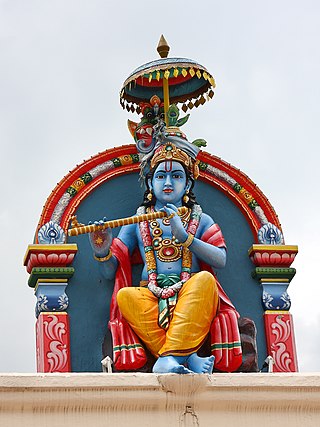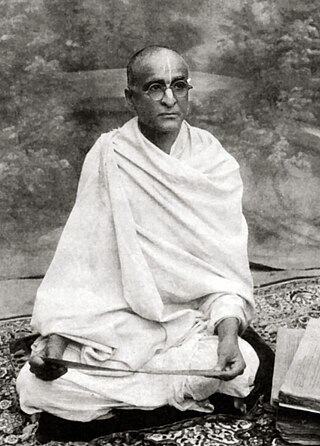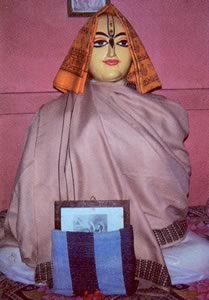Related Research Articles

Krishna is a major deity in Hinduism. He is worshipped as the eighth avatar of Vishnu and also as the Supreme God in his own right. He is the god of protection, compassion, tenderness, and love; and is widely revered among Hindu divinities. Krishna's birthday is celebrated every year by Hindus on Krishna Janmashtami according to the lunisolar Hindu calendar, which falls in late August or early September of the Gregorian calendar.

Hari is among the primary epithets of the Hindu preserver deity Vishnu, meaning 'the one who takes away' (sins). It refers to the one who removes darkness and illusion, the one who removes all obstacles to spiritual progress.

Chaitanya Mahaprabhu was a 15th-century Indian Hindu saint from Bengal who is considered to be the combined avatar of Radha and Krishna by his disciples and various scriptures. Chaitanya Mahaprabhu's mode of worshipping Krishna with bhajan-kirtan and dance had a profound effect on Vaishnavism in Bengal. He was also the chief proponent of the Vedantic philosophy of Achintya Bheda Abheda Tattva. Mahaprabhu founded Gaudiya Vaishnavism. He expounded Bhakti yoga and popularised the chanting of the Hare Krishna Maha-mantra. He composed the Shikshashtakam.

Bhaktisiddhanta Sarasvati, born Bimala Prasad Datt, was an Indian Gaudīya Vaisnava Hindu guru, ācārya, and revivalist in early twentieth-century India. To his followers, he was known as Srila Prabhupāda.

Gaudiya Vaishnavism, also known as Chaitanya Vaishnavism, is a Vaishnava Hindu religious movement inspired by Chaitanya Mahaprabhu (1486–1534) in India. "Gaudiya" refers to the Gaura or Gauḍa region of Bengal, with Vaishnavism meaning "the worship of Vishnu". Specifically, it is part of Krishnaism—Krishna-centric Vaishnavite traditions.

Bhaktivinoda Thakur, born Kedarnath Datta, was an Indian Hindu philosopher, guru and spiritual reformer of Gaudiya Vaishnavism who effected its resurgence in India in late 19th and early 20th century and was called by contemporary scholars as a Gaudiya Vaishnava leader of his time. He is also known along with his son Bhaktisiddhanta Sarasvati, with initiating the propagation of Gaudiya Vaishnavism in the West and its global spread.
Mayapur is a neighbourhood of Bamanpukur, in the Nabadwip CD block in the Krishnanagar Sadar subdivision of the Nadia district, West Bengal, India. It's situated at the confluence of the Jalangi River and the Bhagirathi, a tributary of the Ganges. The area is considered spiritually significant by followers of Gaudiya Vaishnavism.

Jiva Goswami was an Indian philosopher and saint from the Gaudiya Vaishnava school of Vedanta tradition, producing a great number of philosophical works on the theology and practice of Bhakti yoga, Vaishnava Vedanta and associated disciplines. He is known as one of the Six Goswamis of Vrindavan and was the nephew of the two leading figures, Rupa Goswami and Sanatana Goswami.

The Kali-Santarana Upanishad, also called Kalisantaraṇopaniṣad, is a Sanskrit text. It is a minor Upanishad of Hinduism.

In Hinduism, the concept of God varies in its diverse religio-philosophical traditions. Hinduism comprises a wide range of beliefs about God and Divinity, such as henotheism, monotheism, polytheism, panentheism, pantheism, pandeism, monism, agnosticism, atheism, and nontheism.

Radha-Krishna is the combined form of the Hindu god Krishna with his chief consort and shakti Radha. They are regarded as the feminine as well as the masculine realities of God, in several Krishnaite traditions of Vaishnavism.
Vaishnavism is one of the major Hindu denominations along with Shaivism, Shaktism, and Smartism. It is also called Vishnuism since it considers Vishnu as the sole supreme being leading all other Hindu deities, that is, Mahavishnu. Its followers are called Vaishnavites or Vaishnavas, and it includes sub-sects like Krishnaism and Ramaism, which consider Krishna and Rama as the supreme beings respectively. According to a 2010 estimate by Johnson and Grim, Vaishnavism is the largest Hindu sect, constituting about 641 million or 67.6% of Hindus.

Bala Krishna or Bala Gopala, refers to the boyhood form of the Hindu deity Krishna. The worship of Krishna as a divine child was historically one of the early forms of worship in Krishnaism.

Krishnaism is a term used in scholarly circles to describe large group of independent Hindu traditions—sampradayas related to Vaishnavism—that center on the devotion to Krishna as Svayam Bhagavan, Ishvara, Para Brahman, who is the source of all reality, not an avatar of Vishnu. This is its difference from such Vaishnavite groupings as Sri Vaishnavism, Sadh Vaishnavism, Ramaism, Radhaism, Sitaism etc. There is also a personal Krishnaism, that is devotion to Krishna outside of any tradition and community, as in the case of the saint-poet Meera Bai. Leading scholars do not define Krishnaism as a suborder or offshoot of Vaishnavism, considering it at least a parallel and no less ancient current of Hinduism.
Cataphatic theology or kataphatic theology is theology that uses "positive" terminology to describe or refer to the divine – specifically, God – i.e. terminology that describes or refers to what the divine is believed to be, in contrast to the "negative" terminology used in apophatic theology to indicate what it is believed the divine is not.

Gaura Purnima is a Vaishnava festival that celebrates the birth of Chaitanya Mahaprabhu (1486–1534), who founded Gaudiya Vaishnavism. It occurs on the purnima in the Hindu month Phalguna, usually falling in March or April.
Svayam Bhagavan is a Sanskrit concept in Hinduism, referring to the absolute representation of Bhagavan as a singular deity in a monotheistic framework. The concept is most commonly associated with a male deity, for instance in Hindu sub-movements like Krishnaism and Gaudiya Vaishnavism, in which Krishna is regarded as Svayam Bhagavan.

Manipuri Vaishnavism, also known as Meitei Vaishnavism is a regional variant of Gaudiya Vaishnavism with a culture-forming role in the north-eastern Indian state of Manipur.

Haridasa Thakur was a Vaishnava saint known for playing a part in the initial propagation of the Hare Krishna movement. He is considered to be a known convert of Chaitanya Mahaprabhu, apart from Rupa Goswami and Sanatana Goswami. His story of integrity and faith in the face of adversity is told in Chaitanya Charitamrita, Antya lila. It is believed that Chaitanya Mahaprabhu himself designated Haridasa as nāmācarya, meaning the 'teacher of the Name'. Haridasa Thakura was a devotee of the deity Krishna, and is regarded to have practised the chant of his veneration, Hare Krishna, 300,000 times daily.

A kanthi mala, or simply kanthi, is a basil-seed threaded string worn by some adherents of Hinduism.
References
- ↑ Evans, Coby (2019-11-01). Mythology: Legends, Gods, and Myths from India. Self Publisher. p. 12. ISBN 978-88-353-2701-1.
- Dictionary of Hindu Lore and Legend ( ISBN 0-500-51088-1) by Anna Dhallapiccola